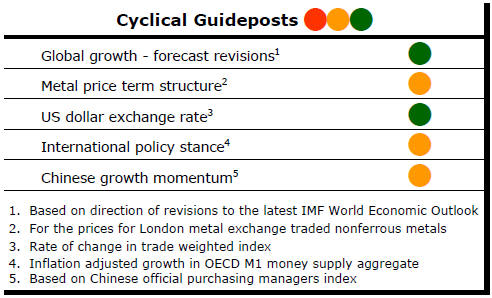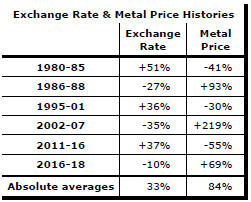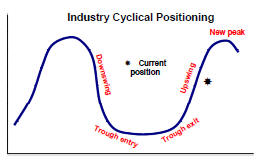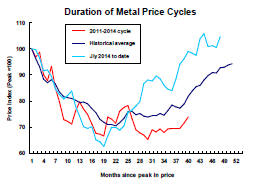The Current View
The PortfolioDirect cyclical guideposts suggest that the best possible macroeconomic circumstances for the resources sector will involve a sequence of upward revisions to global growth forecasts, the term structure of metal prices once again reflecting rising near term shortages, a weakening US dollar, strong money supply growth rates and positive Chinese growth momentum.
Two of the five guideposts are "set to green" suggesting the most arduous part of the cyclical adjustment has passed. Although conditions have improved, the principal macroeconomic drivers do not yet appear to have sufficient momentum to carry the cycle through the upswing phase.

Has Anything Changed? - Updated View
From mid 2014, the metal market cyclical position was characterised as ‘Trough Entry’ with all but one of the PortfolioDirect cyclical guideposts - the international policy stance - flashing ‘red’ to indicate the absence of support.
Through February 2016, the first signs of cyclical improvement in nearly two years started to emerge. The metal price term structure reflected some moderate tightening in market conditions and the guidepost indicator was upgraded to ‘amber’ pending confirmation of further movement in this direction.
As of early December 2016, the Chinese growth momentum indicator was also upgraded to amber reflecting some slight improvement in the reading from the manufacturing sector purchasing managers index. Offsetting this benefit, to some extent, the policy stance indicator was been downgraded from green to amber.
At the end of July 2017, the exchange rate guidepost was upgraded to green.
As 2017 ended, there were emerging signs of economic forecasters beginning a sequence of growth forecast upgrades prompting a revision of the global growth guidepost to "green".
Cyclical Position
The level and direction of metal prices are consistent with the historical average this far into a cycle. A more detailed analysis of metal price cyclical duration is available here.
Time, of itself, is not important but the sequence of adjustments which are typical of a commodity price cycle and contribute to higher prices and changed expectations does take time.
The question now is whether there is enough momentum to carry the industry further into the upswing phase of the cycle. More often than not, progress stalls around this point.
A pullback is not a necessary outcome but an alternative result would most likely require some combination of higher global growth, U.S. dollar weakness or a period of more supportive monetary policies.
Global Growth - Forecast Revisions
Forecasters are flashing warning signs that global economic growth might have already peaked.
In releasing the regular half yearly World Economic Outlook on 17 April, the IMF research director described the world economy as showing broad based momentum but kept the Fund’s global growth projections at 3.9% for both 2018 and 2019.
Generally upbeat assessments of the world economy rely
heavily on what happened in late 2017 rather than on what lies ahead. Global
growth accelerated in 2017 from 3.2% to 3.8%, the strongest increase since
the recovery from the financial crisis during 2010. Improving growth
outcomes in the second half of the year underpinned rising metal usage
following an otherwise lacklustre first half.

In January, the World Bank announced that it, too, had raised its global GDP growth forecast for 2018 from 2.9% to 3.1%. The forecast for 2019 was raised from 2.9% to 3.0%.
The upgrades to the global growth outlook by the two international organisations ostensibly contained some of the best news for the mining industry since 2010.
The strongest increases in metal usage typically occur when global GDP growth is accelerating. Rising growth projections are usually a prompt for strategists to raise sectoral fund allocations.
The not so good news is that 2017 is nearly as good as it gets, in the eyes of the Fund and the World Bank.
 The
IMF analysis points to no difference in average growth rates in the next six
years than in the last six years. Key regions of the world – the USA,
Europe, emerging Asia – face a downward trending growth outlook.
The
IMF analysis points to no difference in average growth rates in the next six
years than in the last six years. Key regions of the world – the USA,
Europe, emerging Asia – face a downward trending growth outlook.
The Fund forecasts are similar to those of the World Bank.
Unusually low productivity growth in most advanced economies, reflecting low business investment spending and governments with little enthusiasm for reform agendas, are constraining how quickly global output can expand.
Legislation to cut taxes in the USA is adding a fiscal stimulus in the near term but whether tax cuts support productivity enhancing capital spending in the next several years to sustain a stronger growth base is less certain.
Meanwhile, a threatened departure from the trade liberalisation forces of the past several decades precipitated by the US administration seeking to capture a larger share of world trade endangers global growth prospects and, ultimately, the prosperity of the mining industry.
Whatever the eventual outcome of the recent threats and counter threats over trade, the resulting uncertainties, left to fester, will retard business investment plans. Signs of this are already evident.
The most important missing piece in the progress of the metal price cycle – a stronger private sector investment commitment – is at risk immediately whatever the eventual impact on trade flows.
US Dollar Exchange Rate - Chart 2
Along with reduced risks to growth, a weaker U.S. dollar contributed to the upward trajectory in metal prices through 2017.
Over the past 45 years, a 1% fall in the US dollar trade
weighted index has come with an average rise of 3% in nonferrous metal prices.

The currency adjustment reflected some reappraisal of relative growth rates and the direction and pace of interest rate changes.
After an initial adjustment to changes in interest rate expectations, markets also responded to further improvements in the outlook for growth in Europe and the diminished risks to growth arising from instability in its financial system
Another negative influence on the US dollar had been the
reduced need in a less risky macro
Some of these factors are now being unwound.
The improvement to Europe growth has lost momentum.
Attention is again focusing on the likelihood of US interest rate changes running ahead of moves in Europe.
Faltering emerging economies have also made investors more sceptical about their growth prospects and their currency upside.
While stronger US growth from a tax and spending driven fiscal stimulus may precipitate a reappraisal of relative growth and interest rates in favour of the US dollar, this is not a sustainable source of upward pressure without structural changes to US growth potential.
In the years ahead, as distinct from the balance of 2018, slower growth and rising US debt will push the currency toward its longer term downward trajectory.
International Policy Stance - Chart 3
Global monetary policies had been set to support higher asset prices as a step toward raising demand and creating stronger employment markets.
As some of the most favourable monetary conditions in modern history are wound back, the mining industry will be relying more heavily on output growth and, for that, on the willingness of governments to foster stronger productivity outcomes to raise global growth potential.
 Stronger productivity growth will facilitate increases in wages and consumer
spending
with fewer worries about rising inflation pressures.
Stronger productivity growth will facilitate increases in wages and consumer
spending
with fewer worries about rising inflation pressures.
The greatest danger to a metal price cycle comes when monetary policy settings begin to tighten in response to higher inflation with an adverse effect on output growth and investment spending.
This far into the cycle, monetary policy settings would usually be tightening, sometimes quite aggressively. Policy settings are changing more gradually than in the past because competitive forces within labour markets are holding back inflation pressures.
While this beneficial effect on inflation has persisted for longer than anticipated, policy is already becoming less supportive as the declining growth in US and global money supply attests.
Metal Price Term Structure - Chart 1
Some tightening in nonferrous metal price spreads was led by emerging backwardations in London Metal Exchange lead and zinc prices.
The tightening in spreads is modest by the standards of what is possible but overall physical market balances do not appear to be changing enough for the shift in premiums to move more dramatically.
 The International Copper Study Group (ICSG) has reported
that demand for the metal in 2017 rose by 0.7%, the smallest annual increase in demand since 2009.
Despite the unusually slow growth in usage, market balances were kept in
check by a decline in mine output.
The International Copper Study Group (ICSG) has reported
that demand for the metal in 2017 rose by 0.7%, the smallest annual increase in demand since 2009.
Despite the unusually slow growth in usage, market balances were kept in
check by a decline in mine output.
After recent revisions, International Lead Zinc Study Group statistics show zinc usage increasing at a 1.2% annual rate between 2010 and 2017 - amongst the slowest growth rates outside periods of recession - compared with a metal output growth rate of 0.4% leading to a multi-year rundown in inventories on a scale which has occurred only twice before in the past 50 years.
Constraints on the supply side have helped deliver tighter market conditions than would otherwise have been experienced but these can be reversed. If the zinc mine production rate in December 2017 were to be replicated through 2018, for example, output would grow by nearly 9% in the current year.
With only moderately increasing rates of usage across the major daily traded metals, relatively narrow metal price spreads may indicate market conditions are insufficiently strong (and possibly subject to reversal if producers choose to do so) to carry the cycle significantly further.
Chinese Growth Momentum - Chart 4
Chinese manufacturing has enjoyed a prolonged expansion
during the past 12 months which has helped build positive sentiment for investments in the
mining sector (as illustrated in the fourth chart in the right hand panel).
The most recent official purchasing managers statistics for manufacturers suggest a recovery from an apparent slowing in activity in the early weeks of 2018.
Current Chinese growth rates remain highly dependent on bank lending despite widespread agreement that the flow of funds is unsustainable and creating longer term distortions which will need addressing.
More accommodating policy settings than have been in place for the past several years are highly unlikely, biasing any cyclical risks for raw material markets to the downside.
 The restructuring of the Chinese economy with the
resulting contraction in the contribution to Chinese GDP of investment
spending will have a generally detrimental effect on raw material demand.
The restructuring of the Chinese economy with the
resulting contraction in the contribution to Chinese GDP of investment
spending will have a generally detrimental effect on raw material demand.
Chinese steel production in 2017 was higher than in 2016 but little different from four years earlier.
Other signs of subdued momentum have been evident in statistics released by the International Copper Study Group and the International Lead Zinc Study group which show global per capita metal usage rates remaining little changed for four consecutive years.
China's official statistical agency reported that GDP had grown by 1.4%, or at an annualised rate of 5.7%, in the March quarter of 2018. The relatively slow pace of growth if maintained would fall significantly short of the growth targeted by Chinese leaders.
Chinese growth is destined to head lower in coming years but China has consistently met annual statistical goals in recent years through periodic growth surges. The same will likely occur in 2018, providing a source for optimism about the raw materials sector through the middle months of 2018, but the effort required to do this year after year becomes progressively harder.



